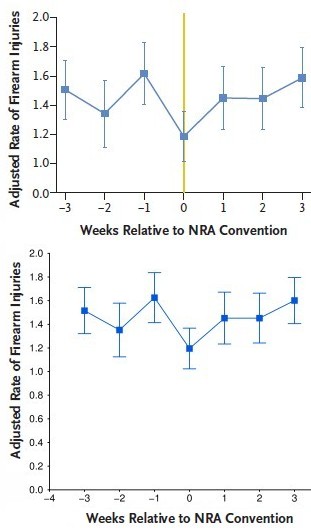 dislike firearms, mainly because they damage your hearing, even if you use them
outdoors. An article came
out recently showing that even on an outdoor firing range, sound-absorbing earmuffs
are insufficient to prevent hearing loss, so I don't plan to use one until somebody
invents a plasma rifle in, oh, say the forty-watt range—with a silencer.
dislike firearms, mainly because they damage your hearing, even if you use them
outdoors. An article came
out recently showing that even on an outdoor firing range, sound-absorbing earmuffs
are insufficient to prevent hearing loss, so I don't plan to use one until somebody
invents a plasma rifle in, oh, say the forty-watt range—with a silencer.
We expect politics in Lancet, but it's depressing to see it make its way to The New England Journal of Medicine, which published a short article in the March 1 2018 issue claiming that firearm injuries decrease during the days of an NRA convention. Even anti-firearm commenters find this hard to explain, since only a tiny minority of firearms owners attend these meetings. They speculate that “firing ranges and hunting grounds” are closed for some reason during the conventions, making accidents less likely.

Firearm injury rates. Top = Jena & Olenski's graph in NEJM, Bottom = correct graph The NEJM graph starts at 0.9 (though it's labeled as 0), making the change look bigger. It also makes the error bars look enormous, so in this case the effect of mis-plotting is debatable. Note: I have been unable to locate a source for the numbers in the paper.
The article claims that 129 firearm-related injuries out of 10,883,304 hospital insurance claims occur during dates when there's an NRA convention, while during equal numbers of days on weeks before or after there were 963 injuries out of 64,683,254 persons.
Why are the two samples so different in size? Because they arbitrarily selected three time intervals on each side, making the reference value six times bigger. If not for this, the result would not be statistically significant.
Another error is in their graph. Whenever you start the y-axis at something other than zero, you have to indicate it, otherwise your result is suspect. Notice in their graph the y axis jumps from 0 to 1, then increases by units of 0.2. This can't be done by mistake—no software creates graphs like this—and it's deceptive.
Let's assume that the date adjustments are done correctly and fairly. Then 14.85 per million of injuries are firearms-related that occur during non-convention dates, but only 11.89 occur during the conventions. The significance is easy to test.
10000 x 129 / 10,883,304 = 0.1185
10000 x 963 / 64,683,254 = 0.1489
chi sq = 5.938
p value = 0.015
Yates p-value 0.017
It looks statistically significant, but there's a problem: most people don't stay for the full length of a conference. In every conference I've ever been to, the auditorium is nearly empty on the last day. As a speaker it's embarrassing to stand in a huge auditorium with only four people in the audience.
I've never been to an NRA convention, but I'd assume they're similar. According to the official site, www.nraam.org, the convention in 2015 was from Friday April 10 to Sunday April 12, or three days. If they stayed two days instead of three, the statistics would be
10000 x 86 /7,255,536 = 0.1185
10000 x 642 / 43,122,169 = 0.1489
chi sq = 3.958
p value = 0.047
Yates p value = 0.053
The Yates correction improves the accuracy for 2×2 contingency tables, which is what we have here. Without the correction, it just squeaks by the skin of its teeth as just barely statistically significant, and not particularly convincing.
Pro-gun advocates see this article, coming two weeks after Parkland, as politically motivated NRA-bashing, and they have a point. To do this test fairly, you'd have to test for seasonal changes throughout the year, and then do a Bonferroni correction or some other correction. If you did, it's likely that none of the differences would be significant. You'd probably find several weeks where just by chance the rate is above or below the mean.
But suppose their results were correct. It would mean that NRA conventions are highly desirable, and that everyone ought to join the NRA, learn about gun safety, and attend the convention, which sounds educational. I doubt the authors really believe their conclusion any more than I do. I would have rejected it on technical grounds, but it's clearly fake news based on statistical noise.
may 06 2018, 5:56 am; last edited 6:07 pm

